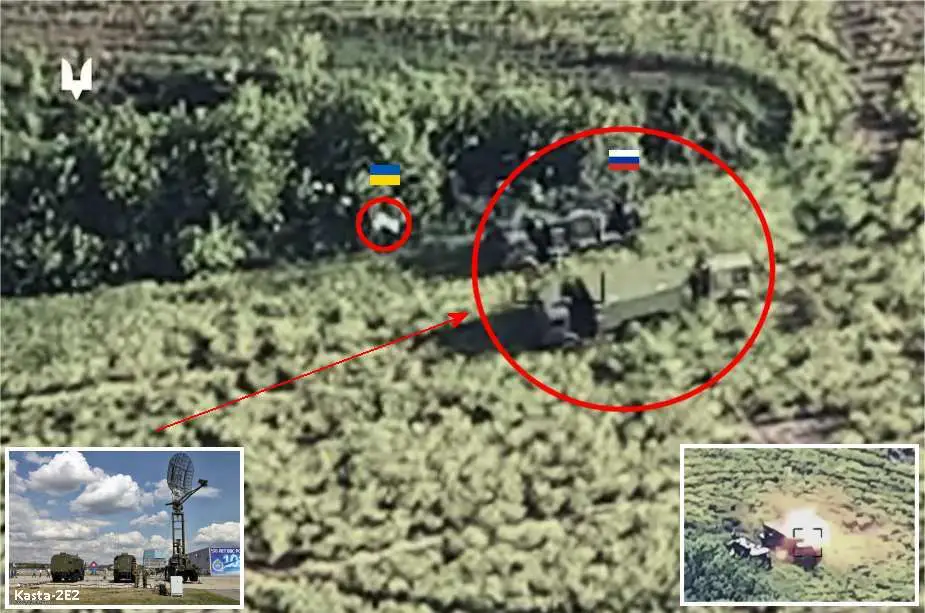Breaking news
Ukrainian Special Forces Destroy Russian Kasta-2E2 State-of-the-Art Mobile Air Control Radar System.
The Ukrainian Special Operations Forces have achieved a significant strategic victory and shifted the regional balance of power. By successfully locating and neutralizing a Russian Kasta-2E2 state-of-the-art mobile air control radar system, they have demonstrated the effectiveness of Ukraine's ongoing defense efforts. This operation, publicly announced on the official Facebook page of the Ukrainian Special Operations Forces on June 3, 2024, has significantly hampered Russian aerial surveillance capabilities in the region.
Follow Army Recognition on Google News at this link

Ukrainian FPV kamikaze drone strikes and destroys Russian Kasta-2E2 mobile air control radar system. (Picture source: Screen Shot Viddeo SOF Ukrainian Facebook)
The Ukrainian Special Operations Forces utilized the latest model of a one-way attack drone, a recent addition to the Ukrainian arsenal, to execute a precision strike against the Kasta-2E2 radar. This advanced radar system, known for its control over airspace and detection of aerial targets, including those flying at ultra-low altitudes, was effectively neutralized. The destruction of the Kasta-2E2 is a significant testament to the Ukrainian forces' technological advancements and their ability to execute precision strikes.
The Kasta radar first appeared on Ukrainian soil in 2021, specifically in the temporarily occupied Luhansk region. Its deployment has been a part of Russia's broader strategy to maintain control over the airspace in contested areas.
Ukrainian SOF drone operators employed aerial reconnaissance during the mission to pinpoint the radar's location. Following the identification, they launched an FVP drone to execute the strike, demonstrating the Ukrainian forces' sophisticated capabilities and operational readiness.

The Russian Kasta-2E2 is a state-of-the-art mobile radar system that detects and tracks low-altitude aerial targets, providing critical airspace monitoring and early warning capabilities. (Picture source Vitaly Kuzmin)
The Russian Kasta-2E2, also known as the 39N6E, is a mobile radar system that plays a critical role in air surveillance and early warning within Russia's air defense network. Developed by the All-Russian Scientific Research Institute of Radio Engineering (VNIIRT), the Kasta-2E2 entered service in the early 2000s and has been integral to Russia's military operations.
One of the primary strengths of the Kasta-2E2 is its ability to detect and track low-altitude aerial targets. These include helicopters, drones, and low-flying aircraft, which are often difficult to identify with higher-altitude surveillance systems. The radar system can monitor airspace at ultra-low altitudes, making it a versatile tool for comprehensive airspace control.
The Kasta-2E2 is also notable for its mobility. As a mobile radar system, it can be rapidly deployed and repositioned to adapt to the battlefield's dynamic requirements. This mobility ensures that the radar can maintain optimal operational effectiveness, even in fast-changing combat situations. The system's ability to relocate quickly provides a tactical advantage, allowing for flexible responses to various aerial threats.
Technically, the Kasta-2E2 boasts impressive surveillance capabilities. It has a range of 5 to 150 kilometers and can monitor a full 360 degrees in azimuth. The radar can detect targets at altitudes of up to 6 kilometers, with an elevation angle of 25 degrees using a 14-meter antenna and 23 degrees with a 52-meter antenna. The scanning interval for the radar can be set to either 6 or 12 seconds, allowing for rapid and continuous airspace monitoring.
The radar's deployment in Ukraine since 2021, particularly in the temporarily occupied Luhansk region, underscores its strategic importance in controlling contested airspace. Its advanced capabilities in detecting and tracking aerial targets contribute significantly to the operational effectiveness of Russian forces in the region.
The Kasta-2E2 represents a sophisticated military technology that enhances Russia's air defense capabilities through its low-altitude detection, mobility, and rapid deployment features. Its recent destruction by Ukrainian Special Operations Forces marks a significant setback for Russian military operations in Ukraine, highlighting the ongoing technological and tactical advancements in the conflict.
The ongoing conflict in Ukraine, initiated by Russia's annexation of Crimea in 2014 and the subsequent unrest in Eastern Ukraine, has seen various escalations and shifts in military tactics. The war has tested the resilience and adaptability of the Ukrainian armed forces and highlighted the importance of technological advancements in warfare.
Ukrainian forces' destruction of the Kasta-2E2 radar underscores the conflict's evolving nature, where high-tech warfare and intelligence operations play a crucial role. As Ukraine continues to bolster its defensive and offensive capabilities, operations like these are vital in diminishing the adversary's technological edge.
This latest success showcases Ukraine's Special Operations Forces' growing proficiency and ability to leverage advanced technologies to protect their nation's sovereignty. The engagement also reflects the broader strategic imperative of countering Russian advances and maintaining control over Ukrainian airspace, which remains a critical aspect of the ongoing war.


























